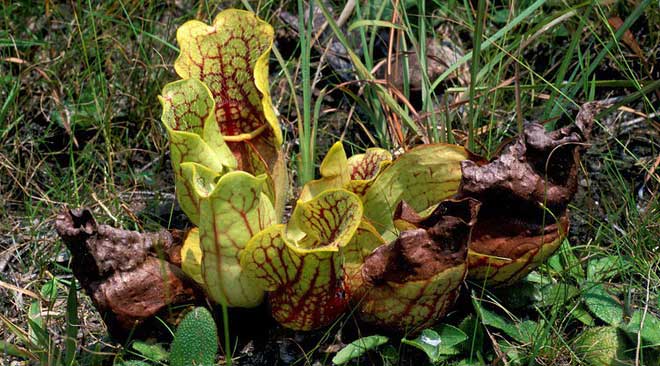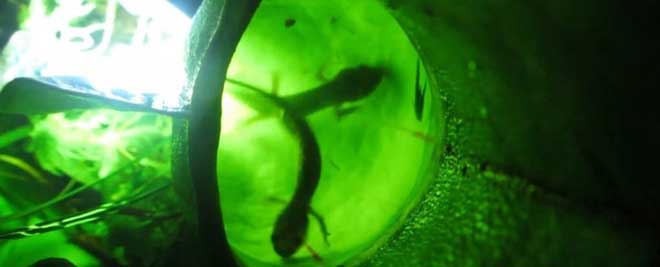Discover more of the terrifying ability of carnivorous plants in North America
The trees in this world not only enjoy peace, but also carnivorous plants. They are even considered to be opportunistic and ruthless predators: just ignore, the prey will die in the digestive tank of acid, to die slowly and extremely painfully.
However, except tropical plants, such as Malaysia's giant Nepenthes rajah , can hunt rats, most predatory species usually target only small insects. However, according to a recent discovery, there is another species of carnivorous plants that live in Canada also capable of hunting and digesting vertebrates. And the amazing thing is, this plant is much smaller than Nepenthes rajah.

Sarracenia purpurea purpurea L.
The species with the scientific name is Sarracenia purpurea purpurea L. , which is also in the warm family. They live in a very peaceful park in Ontario, Canada - where there are frequent biologists visiting. However, their ability was discovered by a biology student named Teskey Baldwin, not a famous scientist.
It was a day in 2017, when Baldwin discovered that the pitcher plant was trapping a young lizard. As mentioned, the hunt for vertebrate animals for the warm lid is common in the tropics, but very rare for the carnivorous plants that live in the North. Therefore, Baldwin was surprised, and from there experts began to conduct further research on the plant.

The pitcher tree is trapping a young lizard.
Scientists from the University of Guelph and the University of Toronto have been examining hundreds of pitcher plants in four different surveys."Overall, there are about 8 lizards found inside warmed plants in 2017. In the 2018 survey, the number increased to 35." - Research report said.
In the last 2 surveys, up to 20% of the trees tested contained the lizard's body inside. Mostly the yellow-black lizard (Ambystoma maculatum) , the young is the size of a human finger. There are even trees that catch a turn of 2-3 lizards at the same time.
Experience the horror of the victim
What happens when a warm lid is really tragic. Within 3 days, the prey will weaken, shifting from a very kicking state to a period of loss of consciousness due to acid and internal heat. For one thing, the moment they took their last breath, it must be 19 days later.
In other words, the victim of the pitcher plant must have a very slow death, no different from torture. After death, the body will be decomposed by the digestive enzymes of the plant - lasting about 10 days, creating nutrients for plants. This process can create an extremely characteristic stench.
But there is still a problem, is that how the lizards easily get into their heads? We can ignore the "accident" factor, because the rate of seeing lizards is very high.
At this point, scientists said they did not have the correct answer, but some hypotheses were made. First of all, it may be because of lizards who want to grab the insects that this plant often eats. Another theory might be that they are stuck when they want to escape from other predators.
"While hiding the tree that someone attacked, the lizards often immediately went straight to the bottom of the tree, then realized that they were flooded with digestive juices," explained the experts.
"They will continue to swim crazily, until the danger is over. However, their lives since then are considered to be no longer available."

A lizard can provide enough nitrogen to feed three warm plants.
And overall, the lizards of these lizards are an extremely valuable source of nutrition - specifically nitrogen. Experts say a lizard can provide enough nitrogen to feed three warming plants.
The study was published in The Scientific Naturalist.
- Discover scary carnivorous plants in Canada
- Discover scary carnivorous plants in Canada
- Extremely hidden carnivorous plants
- Whether or not Man-Eating Tree?
- Super-fast prey speed of carnivorous plants
- Detecting new carnivorous plants
- Discover many rare plants in ancient caves in America
- The richest carnivorous marsh in the world
- Radioactive leaks from Japan are spreading to North America
- Discovered new carnivorous plants in Japan
- Bats use carnivorous plants as a toilet
- The killer tree is also afraid of poison
- Carnivore fossils 40 million years old
 Why do potatoes have eyes?
Why do potatoes have eyes? 'Tragedy' the world's largest carnivorous life: Death becomes ... public toilet
'Tragedy' the world's largest carnivorous life: Death becomes ... public toilet Tomatoes were once considered 'poisonous' for 200 years
Tomatoes were once considered 'poisonous' for 200 years Detecting microscopic parasites on human face
Detecting microscopic parasites on human face